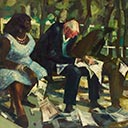Untitled (II) 2000
139 x 156 cm
est. $50,000 - 80,000
 Relative size
Relative size
PROVENANCE
A Corporate Collection
In Poland, as in other parts of Europe, dark-plumaged crows can occasionally be seen gathered around their deceased own as if mourning for the dead bird. The sight is well-known. The phenomena of these funereal birds standing around carefully studying the victim as a group, has become known as the Crows Funeral for obvious anthropomorphic reasons
What is actually happening, according to recent research, is the crows are trying to identify the cause of death and by association the 'bringer of harm' in order to know how to avoid a similar fate. It is now known that where the death has been caused by a creature of prey or human that is identifiable, the participating crows are able to pass this knowledge on to other crows that were not present at the 'funeral' and the recognition of the perpetrator persists, and in fact grows for months afterwards
Hammond's birds, also relatively still, clustered in groups, have also taken on mythic proportions in writing and conversation since the artist's career-changing visit to New Zealand's sub-Antarctic islands in 1989. Immediately on his return his works were populated with attenuated bird figures, sometimes half-human half-bird. The artist's southern epiphany also awakened an interest in the 19th century ornithologist Sir Walter Buller, who was responsible, almost in equal measure for the lavish documentation of many species that became extinct before the 20th century and for contributing to their extinction through his practice of killing, stuffing and distributing vast numbers of birds for ornithological collections
It is clear therefore that the symbolic power of Hammond's paintings, drawings and lithographs address the threat to New Zealand wildlife by humans, past, present and future. Hammond's birds stand both as witness and accuser in Buller's world, for the artist conjures a primordial avian world, not of delicate vulnerability, but of tooth and claw power. His birds lay in wait, watch, stalk and loom over the human forms that occasionally appear in their midst or in the distance
In Untitled (II) from 2000 we are taken behind the scenes. The work seems like a page from the 'Avian Defence Ministry's Home Guard Manual'. The bird with its head above the clouds is part of the collective early-warning system. The large bird on the right demonstrates the armoury of the land: strong-arm hills for protection and massive, uprooted trees as weapons. Finally, methods of capture are indicated with the steel hoop surrounding the kneeling figure in the middle foreground
Just as Crows' funerals are forensic gatherings in order to divine safe passage in the future: to name, know and warn of the enemy; Hammond's birds gather, in preparation for the inevitable return of devastation. Their premonition of future harm musters them to plan carefully and then to stand with singularly menacing threat, ready to repel their enemies rather than flee
Rob Garrett




